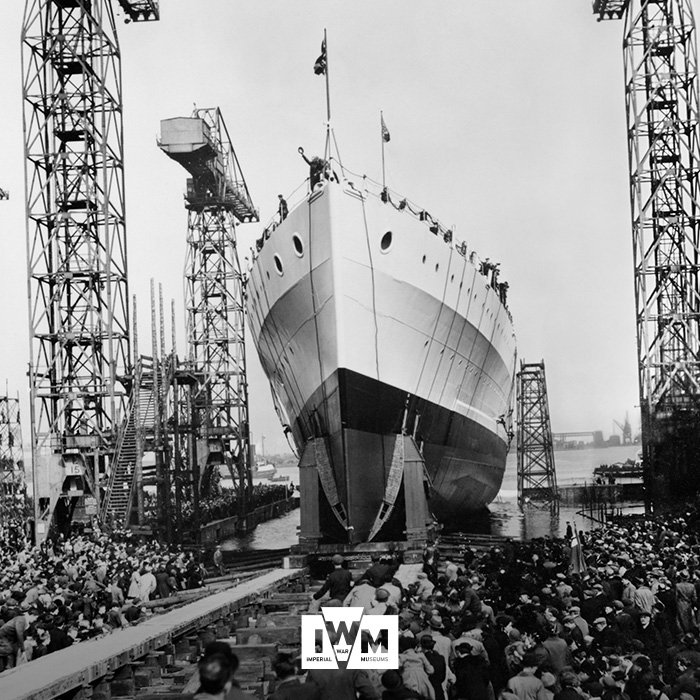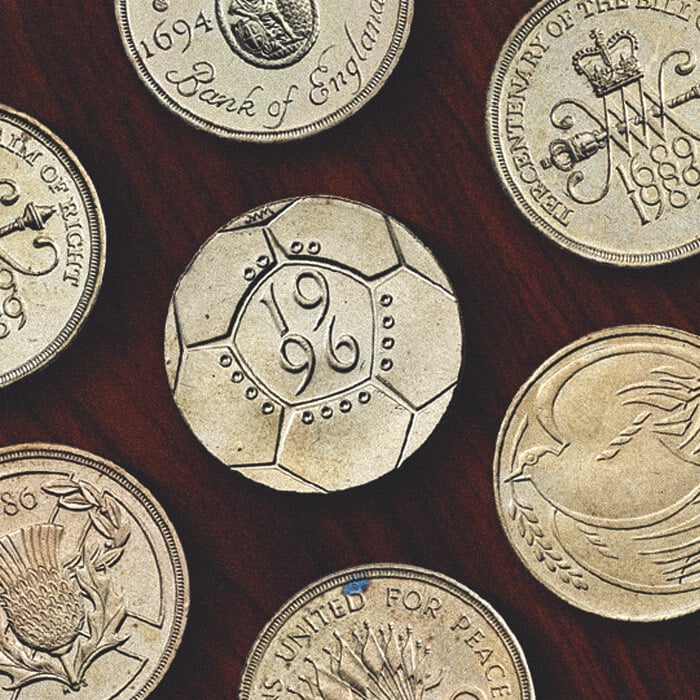
1936
On 10 December, the keel of the cruiser ‘Job Number 1000’ is laid down at Harland & Wolff shipyard in Belfast, the same yard where Titanic was built. The ship’s estimated cost is £2.14 million.
1938
Belfast is launched on St Patrick’s Day, 17 March, by Anne Chamberlain, the wife of British Prime Minister Neville Chamberlain.
1939
After more than a year of fit-out and completion, the finished ship is commissioned on 5 August, officially becoming HMS (His Majesty’s Ship) Belfast with a ship’s company of 761 officers and men. Less than a month later, on 3 September, Britain and France declare war on Germany, marking the start of the Second World War. Belfast is assigned to Northern Patrol for the protection of trade and offensive action. Whilst patrolling the northern waters off Iceland, the ship is hit by a devastating magnetic mine after just two months at sea.


1942
After three years of inactivity due to the damage sustained by the mine, HMS Belfast rejoins the Home Fleet. Still the largest and most powerful cruiser in the Royal Navy, the ship was immediately called into action. Equipped with the most advanced radar systems, it played a crucial role in protecting the arctic convoys navigating Russia’s supply route throughout the war.
1943
On 26 December, Belfast, HMS Norfolk and HMS Sheffield engage with Scharnhorst, one of the German navy’s most powerful warships, whilst escorting convoys of Allied merchant ships into and out of the Soviet Union. In what is now known as the Battle of North Cape, HMS Belfast plays a key role in sinking this formidable German warship.


1944
On 6 June, Belfast is at the centre of the Allied bombardment of the Normandy beaches to cover the landing of American, British and Canadian troops on D-Day, the largest amphibious assault in the history of warfare.
1945
With the war in Europe over, and after an extensive refit, HMS Belfast leaves Britain in June to join the war against Japan. On 15 August, it arrives at the Australian port of Fremantle on the day the Japanese surrender and begins its many years of service in Asian waters.
1950
North Korea invades South Korea in June and Belfast immediately becomes part of the United Nations’ response. In August, the ship briefly returns to Britain to be recommissioned at war strength.
1951
Following a refit in the United Kingdom to build its strength to a war footing, HMS Belfast returns to the Korean War in January 1951 and the ship remains in service until September 1952. During this prolonged period, its admiral also commands most of the Commonwealth naval ships off the West Coast.
1953
Beginning in 1953, significant debate wages on regarding what to do with HMS Belfast. With its future uncertain, the ship’s fate hangs in the balance for three years before the decision is made to rebuild it for modern warfare.
1956
After three years of indecision, extensive modernisation of Belfast begins to meet the threats of nuclear, biological and chemical warfare as part of the Cold War.
1959
Following HMS Belfast’s recommission at Devonport in May, the ship is deployed back to the waters of Asia, spending long periods at Singapore and Hong Kong, in addition to visiting Australia. These actions are part of Britain’s commitment to the Southeast Asia Treaty Organization and the West’s defence of its interests against Communist expansion.
1961
On 8 December, Belfast acts as the guard ship at the granting of independence to Tanganyika in East Africa; Prince Philip attends a dinner party on board the ship.
1962
On 26 March, HMS Belfast leaves Singapore for the last time, returning home via the Pacific Ocean, west coast of the United States and Canada, and the Panama Canal, reaching Portsmouth on 19 June.

1966–71
Belfast acts as the headquarters and accommodation ship for naval reservists in Fareham Creek, Portsmouth, under the name HMS Bellerophon.
1967
On 14 April, the Director General of the Imperial War Museum (IWM) and members of his staff visit the ship and begin investigating whether HMS Belfast could be turned into a museum ship.
1971
With attempts to save Belfast proving unsuccessful, the UK Government announces it is to be scrapped. In February, the HMS Belfast Trust is formed by the ship’s last operational captain, Rear Admiral Sir Morgan Morgan-Giles MP. He succeeds in persuading the government to allow the Trust to preserve the ship and it arrives in London at its current berth, opening to the public on 21 October, Trafalgar Day.
1978
After long discussions with IWM, the museum takes over the ship from the HMS Belfast Trust on 1 March. Belfast becomes the third branch of the Imperial War Museum and the largest object in the museum’s collection.
1982
On 15 September, HMS Belfast is towed down the Thames to Tilbury New Dry Dock for a six-week inspection and epoxy resin painting of its hull; it returns to the Pool of London on 19 October.

1986
Shipbuilding apprentices restore a traditional wooden deck comprising 2,225 metres of teak planking, completing the work in November.
1988
HMS Belfast celebrates its 50th anniversary. To mark the occasion, its powerful guns are ceremonially fired as former crew members look on.
1999
Towed to Portsmouth in June, Belfast leaves its home in London to be dry docked for cleaning and maintenance. This is the first time the ship has been to sea for 28 years but the second time it has been dry docked.
2010
The Severnaya Verf shipyard of St Petersburg replaces HMS Belfast’s lattice masts in recognition of the ship’s help to Russia through the Arctic Convoys. The new masts are dedicated on 19 October.
2018
Ahead of its 80th anniversary, members of the public are invited aboard Belfast to help get the ship looking its best for its celebration year. Led by a dedicated conservation team, the public activity is dubbed the ‘Ship Shape’ programme. The celebrations themselves involve a programme of events planned by IWM throughout the ship’s 80th year.
2024
Watched by hundreds of people, the ship’s guns are ‘fired’ in a pyrotechnic simulation on 6 June to commemorate the 80th anniversary of D-Day.
Today
HMS Belfast, the last surviving British cruiser from the Second World War remains a famous London landmark, attracting hundreds of thousands of visitors each year.


